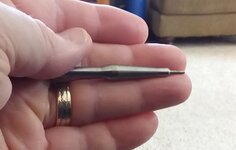- Messages
- 630
- Reactions
- 973
I've got a question about how to proceed. I'm starting to reload 30-30 now that my "severely abused 30-30" project is completely restored. I've started hand-priming, use a universal decapper for all my brass, and I use a Lee Factory Crimp die whenever it makes sense. I am using a Lee Classic Turret press.
For the Lee 30-30 carbide die set, the decapper rod for the sizing die also serves as the case mouth flare tool. The powder die also does not flare the case mouth as it does with 223, 9mm, 38, and 44 die sets. During the load development, I started with the powder drop station, then the bullet seating die, and finally a light crimp with the FCD. Since the case mouth was not flared, I have to be VERY careful when placing the bullet into the seating die to prevent crushing the edge of the case mouth.
Here's the question. I want to flare the case mouth before I seat the bullet. Is it recommended to "grind" off the decapping portion of the sizing rod to leave just the flaring portion of the rod in place (remember I use a hand primer)? Normally I resist grinding off anything related to reloading equipment since they are machined tools with tight tolerances!

For the Lee 30-30 carbide die set, the decapper rod for the sizing die also serves as the case mouth flare tool. The powder die also does not flare the case mouth as it does with 223, 9mm, 38, and 44 die sets. During the load development, I started with the powder drop station, then the bullet seating die, and finally a light crimp with the FCD. Since the case mouth was not flared, I have to be VERY careful when placing the bullet into the seating die to prevent crushing the edge of the case mouth.
Here's the question. I want to flare the case mouth before I seat the bullet. Is it recommended to "grind" off the decapping portion of the sizing rod to leave just the flaring portion of the rod in place (remember I use a hand primer)? Normally I resist grinding off anything related to reloading equipment since they are machined tools with tight tolerances!












